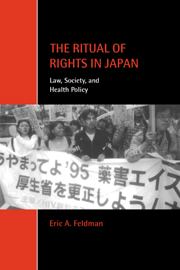Book contents
- Frontmatter
- Contents
- Preface
- Acknowledgments
- 1 Reconsidering rights in Japanese law and society
- 2 Rights in Japanese history
- 3 Patients, rights, and protest in contemporary Japan
- 4 AIDS policy and the politics of rights
- 5 Asserting rights, legislating death
- 6 Litigation and the courts: talking about rights
- 7 A sociolegal perspective on rights in Japan
- Notes
- Bibliography
- Index
2 - Rights in Japanese history
Published online by Cambridge University Press: 08 July 2009
- Frontmatter
- Contents
- Preface
- Acknowledgments
- 1 Reconsidering rights in Japanese law and society
- 2 Rights in Japanese history
- 3 Patients, rights, and protest in contemporary Japan
- 4 AIDS policy and the politics of rights
- 5 Asserting rights, legislating death
- 6 Litigation and the courts: talking about rights
- 7 A sociolegal perspective on rights in Japan
- Notes
- Bibliography
- Index
Summary
THE ROOTS OF “RIGHTS”
Concepts functionally similar to rights can be found early in Japanese history. Until Japanese legal experts began translating European law during the Meiji Restoration (late nineteenth century), however, there was no word that directly translated as “rights” in Japanese. The translation of the word “rights” is therefore important in framing the discussion of rights in contemporary Japan. In itself an interesting piece of intellectual history, the translation more importantly indicates that the social and political significance of rights was understood in Japan by government officials, intellectuals, and social reformers. Were rights merely a foreign import lacking resonance in Japan, it is unlikely that the translation would have been so hotly contested.
Meiji reformers set off in the 1870s to study European legal systems and codes. Some went to Holland, others to Germany, still others to France and England. Their objective was to create a new legal system for Japan, in large part to avoid the humiliation of foreign extraterritoriality laws. Much of their work entailed gaining proficiency in foreign legal languages so that they could translate codes and other legal documents into Japanese. In doing so, they transformed virtually the entire range of legal language, from narrow technical terms to words describing entire categories and concepts. Most new words, created through a process in which Chinese characters were combined into new blends of sound and meaning, generated little controversy.
- Type
- Chapter
- Information
- The Ritual of Rights in JapanLaw, Society, and Health Policy, pp. 16 - 37Publisher: Cambridge University PressPrint publication year: 2000

